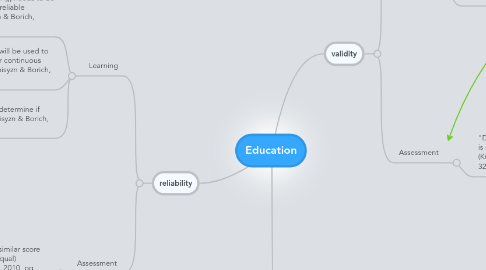
1. reliability
1.1. Learning
1.1.1. The information learned from the teaching, needs to be tested properly by using a test which is reliable assessment of the information (Kubisyzn & Borich, 2010).
1.1.2. The tests, which are reliable, will be used to make placement decisions for continuous learning for the students (Kubisyzn & Borich, 2010).
1.1.3. The assessments are used to determine if learning has taken place (Kubisyzn & Borich, 2010).
1.1.3.1. If the assessments are not a reliable source of information, then it is impossible to judge if the learning has taken place (Kubisyzn & Borich, 2010).
1.2. Assessment
1.2.1. "Does the test yield the same or similar score rankings (all other factors being equal) consistently?" (Kubisyzn & Borich, 2010, pg 329).
1.2.1.1. Test-retest or stability (Kubisyzn & Borich, 2010).
1.2.1.1.1. "Obtained by administering the same test twice to the same group of individuals, with a small time interval between testing, and correlating the scores" (Kubisyzn & Borich, 2010, pg 349).
1.2.1.2. Alternate forms or equivalence (Kubisyzn & Borich, 2010).
1.2.1.2.1. Giving and assessing the scores similar, alternate, but equivalent tests to the same group of students (Kubisyzn & Borich, 2010).
1.2.1.3. Internal consistency (Kubisyzn & Borich, 2010).
1.2.1.3.1. Split-half methods (Kubisyzn & Borich, 2010).
1.2.1.3.2. Kuder-Richardson methods (Kubisyzn & Borich, 2010).
2. validity
2.1. Learning
2.1.1. "The first step in the model (the three stage model of classroom measurement0 is the first step in constructing a criterion-refernced test" (Kubisyzn & Borich, 2010, pg 98).
2.1.1.1. Stage 1: Instructional objectives (Kubisyzn & Borich, 2010).
2.1.1.1.1. Teaching using instructional objectives gives a clear cut idea of what should be learned on a lesson basis (Kubisyzn & Borich, 2010).
2.1.1.1.2. These objectives need to be valid for the students; based on their age, knowledge, etc. (Kubisyzn & Borich, 2010).
2.1.1.2. Stage 2: Instructional activities (Kubisyzn & Borich, 2010).
2.1.1.2.1. Using activities, which support the learning objectives, will allow for learning from all types of learners (Kubisyzn & Borich, 2010).
2.1.1.3. Stage 3: Test (Kubisyzn & Borich, 2010).
2.1.2. To ensure learning happens, the learning, teaching, and objectives must be valid for the students (Kubisyzn & Borich, 2010).
2.2. Assessment
2.2.1. "Does the test measure what it is supposed to measure?" (Kubisyzn & Borich, 2010, pg 329).
2.2.1.1. Content Validity Evidence (Kubisyzn & Borich, 2010).
2.2.1.1.1. To create a test that has items which matches and measures objectives (Kubisyzn & Borich, 2010).
2.2.1.1.2. "Content validity evidence is established by comparing test items with instructional objectives (e.g., with the aid of a test blueprint) to determine whether the items match or measure the objectives" (Kubisyzn & Borich, 2010, pg 334).
2.2.1.2. Concurrent criterion-related validity evidence (Kubisyzn & Borich, 2010).
2.2.1.2.1. To create a test which has similar performance skills and behavior as an already established test (Kubisyzn & Borich, 2010).
2.2.1.2.2. "Criterion-related validity evidence is established by correlating test scores with an external standard or criterion to obtain a numerical estimate of validity evidence" (Kubisyzn & Borich, 2010, pg 339).
2.2.1.3. Predictive criterion-related validity evidence (Kubisyzn & Borich, 2010).
2.2.1.3.1. To create a test, in which scores can predict future performance, both successes and failures(Kubisyzn & Borich, 2010).
2.2.1.3.2. "Criterion-related validity evidence is established by correlating test scores with an external standard or criterion to obtain a numerical estimate of validity evidence" (Kubisyzn & Borich, 2010, pg 339).
